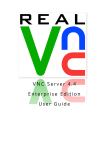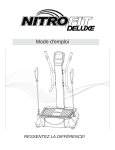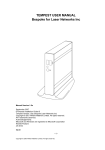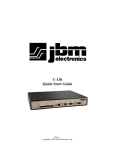Download VNC Viewer 4.4 Enterprise Edition User Guide
Transcript
VNC Viewer 4.4 Enterprise Edition User Guide Copyright and Confidentiality Copyright Statement Copyright © RealVNC Ltd, 2008. All rights reserved. No part of this documentation may be reproduced in any form or by any means or be used to make any derivative work (including translation, transformation or adaptation) without explicit written consent of RealVNC. Confidentiality Statement All information contained in this document is provided in commercial confidence for the sole purpose of use by an authorised user in conjunction with RealVNC’s products. The pages of this document shall not be copied, published, or disclosed wholly or in part to any party without RealVNC prior permission in writing, and shall be held in safe custody. These obligations shall not apply to information which is published or becomes known legitimately from some source other than RealVNC. Registered office: VNC House, Sturton Street, Cambridge, CB1 2SN, United Kingdom. www.realvnc.com Author Issue System Release Date Copyright © RealVNC Ltd, 2008. All rights reserved. 4.1.1 4.1.1 15 May 2008 -2Copyright © RealVNC Ltd 2008. All Rights Reserved. Contents Introduction to VNC...................................................................................................................................................................... 4 Security ......................................................................................................................................................................................... 4 Authentication ...................................................................................................................................................................... 4 VNC link encryption ............................................................................................................................................................ 4 Installing VNC Viewer ................................................................................................................................................................... 6 Starting VNC Viewer ..................................................................................................................................................................... 6 Making a VNC Viewer connection ................................................................................................................................. 6 Starting VNC Viewer from the Quick Launch toolbar icon ................................................................................... 7 Configuration options .................................................................................................................................................................. 9 Display options ........................................................................................................................................................................10 Input options ............................................................................................................................................................................11 Connection options ................................................................................................................................................................ 12 VNC Toolbar .................................................................................................................................................................................. 14 VNC Chat......................................................................................................................................................................................... 15 To start a chat .....................................................................................................................................................................15 VNC Chat options ..............................................................................................................................................................16 Copying messages from chats ......................................................................................................................................17 The VNC Address Book ..............................................................................................................................................................18 To add an entry to the address book .........................................................................................................................18 To edit a VNC Viewer Address book entry: ..............................................................................................................19 To change VNC Address Book settings .....................................................................................................................20 VNC Viewer F8 menu ..................................................................................................................................................................21 Making a VNC Viewer connection using a web browser ..............................................................................................23 Limitations of VNC Viewer for Java .............................................................................................................................24 Using the Listening Viewer .......................................................................................................................................................24 To start the VNC Viewer in listening mode ..............................................................................................................25 To stop listening viewer mode......................................................................................................................................25 Technical Support ........................................................................................................................................................................26 Acknowledgements........................................................................................................................................................... 26 Appendix .........................................................................................................................................................................................27 Ports .............................................................................................................................................................................................27 IP Addresses ..............................................................................................................................................................................28 Windows Version Support ...................................................................................................................................................29 -3Copyright © RealVNC Ltd 2008. All Rights Reserved. Introduction to VNC Virtual Network Computing (VNC) is remote desktop access software which allows one computer (the viewer) to take full control of another (the server), whether on a local network or anywhere in the world over the internet. The computers don’t even have to share the same operating system; for example, you could use VNC to view and control a Windows Vista desktop at work, using a Linux or Mac computer at home. Applications of VNC include remote access, home-working, remote maintenance, helpdesks and business collaboration. As shown in the diagram below, VNC consists of a server and a viewer: • The VNC Server is the software application on the computer to be remotely accessed. • The VNC Viewer is the software application that watches and interacts with the VNC server on the remote computer. This guide provides information on the installation, configuration, and use of VNC Viewer. For detailed information on VNC Server, please see the separate user guide. Security Authentication Open network connections pose a number of security challenges and the VNC system has now been updated to provide robust solutions. In addition to the possibility of attackers attempting to gain server access, there is also the chance that false servers can “spoof” or mimic real ones and lure users into disclosing important information. To defend against server attackers, VNC Server Enterprise Edition provides secure password protection. To defeat server “spoofers”, VNC Servers are now required to prove their authenticity by providing a unique identity code before any viewer details are declared. These features are combined with the new high strength link encryption to present a sizeable barrier to attackers. VNC link encryption Network links in general and the internet in particular, pose an ever present threat of system spoofing and eavesdropping on connections between systems. The VNC Enterprise Edition authentication system -4Copyright © RealVNC Ltd 2008. All Rights Reserved. defeats the former threat, while strong data encryption of the type used by VNC presents a significant barrier to eavesdroppers. When either VNC Viewer or VNC Server enables encryption, both parties exchange encryption keys. From that moment, all information is encrypted prior to transmission. -5Copyright © RealVNC Ltd 2008. All Rights Reserved. Installing VNC Viewer VNC Viewer is an optional component of the VNC Enterprise Edition installer. It is also available as a stand-alone program for download from our web site. The rest of this document will assume that you have done a full install of VNC Enterprise Edition, including VNC Viewer. Please see the VNC Server user guide for details. Starting VNC Viewer 1. Click the Windows Start button, then point to Programs (or All Programs), then point to RealVNC ÎVNC Viewer: This displays the VNC Viewer: Connection Details dialog: NB: If you accepted the option during installation, you can also start the VNC Viewer by clicking the VNC Viewer quick launch bar icon. Making a VNC Viewer connection 1. In the Server text field, enter the name of the server or IP address of the remote VNC Server. 2. Click the Connect button. 3. If it is the first time you have made a connection to the server, a secure signature will be displayed; click Yes to accept the signature: -6Copyright © RealVNC Ltd 2008. All Rights Reserved. 4. If required, you will then be prompted to enter your username and password for the remote server: 5. The VNC Viewer will show you the current desktop of the remote system, and will allow you to control it: VNC Viewer VNC Viewer window toolbar Your local computer desktop NB: You can run two or more VNC Viewer Windows in order to view multiple remote systems Starting VNC Viewer from the Quick Launch toolbar icon During the VNC installation, an option was available to create a VNC Viewer quick launch icon. If this option was chosen, then your system will show a VNC icon on the Windows quick launch bar: VNC Viewer icon 1. Click the VNC icon to launch VNC Viewer. If you wish to create a VNC Viewer quick launch icon, click and drag the VNC Viewer entry from the Start menu over the quick launch area. Position the cursor between two existing quick launch icons (a small vertical black line will appear) and then release the mouse button. -7Copyright © RealVNC Ltd 2008. All Rights Reserved. NB: If the Quick Launch toolbar is not visible, right-click on the Windows task bar, and on the context menu, point to Toolbars, and then select Quick Launch. NB: The quick launch icon feature is not available in Windows 95, or, NT4. -8Copyright © RealVNC Ltd 2008. All Rights Reserved. Configuration options On the VNC Viewer: Connection Details dialog, click Options. This displays the VNC Viewer Properties dialog as shown below: The first time that you start VNC Viewer, the VNC Viewer Properties dialog will display in basic mode with the most frequently used configuration options. In order to display all of the available configuration options, click the Advanced button. (To switch back to basic mode, click the Basic button at any time). THIS GUIDE WILL ASSUME THAT YOU ARE WORKING IN ADVANCED MODE. -9Copyright © RealVNC Ltd 2008. All Rights Reserved. Display options The Display tab on the VNC Viewer Properties dialog allows you to configure how the remote server should be displayed in the Viewer: Display Option No scaling Scale to window size Custom scaling Preserve Aspect Ratio Full Screen Mode Enable Toolbar Description Remote screen is displayed on the Viewer at without any stretching or squeezing. Remote screen is scaled to fit the viewer’s window size. Remote screen is scaled to fit your pre-chosen scaling size or to fit a given size. The aspect ratio of the remote screen is maintained regardless of the viewer window size. The remote server screen is maximised to fit the viewer screen, and may be displayed with scroll bars. The quick access toolbar is displayed at the top of the viewer window. Let VNC Viewer automatically select a balance between the Adapt to Network Speed number of colours displayed and viewer responsiveness, based on your connection speed. Best compression/Best Quality Allows you to manually select a balance between the number of colours displayed and VNC Viewer responsiveness. Always use best available colour Forces VNC Viewer to use the maximum number of colours quality even on a slow connection. For example, to view photographs. - 10 Copyright © RealVNC Ltd 2008. All Rights Reserved. Input options The Inputs tab on the VNC Viewer Properties dialog allows you to configure which events (keyboard, mouse etc) are transmitted to the server: • To allow all inputs (keyboard, pointer, clipboard, file sharing), on the Inputs drop-down list, select Enabled. • To disable all inputs so that the viewer runs in “View Only” mode (useful for demonstrations to multiple viewers), on the Inputs drop-down list, select Disabled. • To choose a custom level, on the Inputs drop-down list select, Custom, and then select the options you require by clicking the appropriate check box. Input Option Description Enable keyboard input Keyboard events are passed to the server. Special keys are passed directly to the server, rather than being interpreted by the viewer machine. VNC Special keys are the following: Pass special keys directly to server Windows key, Print Screen, Alt+Tab, Alt+Escape Ctrl+Escape. Enable mouse input Mouse movements and clicks are passed to the server Allows you to emulate a 3 button mouse to the remote server Enable 3 button mouse emulation system using a 2 button mouse. To replicate the middle mouse button, press the left and right button simultaneously. - 11 Copyright © RealVNC Ltd 2008. All Rights Reserved. When enabled, the mouse position will be sent less frequently Rate-limit mouse events to the remote server. This can be useful for slow modem connections because bandwidth is reduced. However, it can result in a noticeable “jerkiness” to mouse pointer movement. Any text that is cut or copied to the Windows clipboard of the Viewer system is also placed on the clipboard of the server and Share clipboard with server vice versa. This allows cut, copy, and paste to and from the remote server and vice versa. NB: Servers can be configured to refuse clipboard data from viewers. Enable file transfer Allows you to send and receive files between the viewer and server. Allows you to alter the function key, (usually F8) that displays Menu Key the option menu within the VNC Viewer window. Choose None to disable this feature. Connection options The Connections tab allows you to configure how you connect to the remote server: NB: Some companies and home networks prevent connections from being made to computers in other networks, including other machines on the wider internet. In such cases you may be provided with access to a proxy server which acts as a gateway to other networks. - 12 Copyright © RealVNC Ltd 2008. All Rights Reserved. Input Option Shared connection (do not disconnect other viewers) Description When enabled, the VNC Viewer will NOT request that any other existing connections to the remote server are terminated. When enabled, if the server supports single sign-on, the Use single sign-on if the VNC Server Viewer’s user logon credentials will be presented to the server supports it automatically. If these credentials are refused, then the user will be prompted to supply a username and password. VNC Viewer will make a direct connection to any VNC Server. Do not use a proxy (recommended) In most cases, a proxy server will not be necessary to use VNC, and so this option is the recommended default. VNC Viewer will use the same proxy servers as Microsoft Internet Explorer uses (if any). In environments where a proxy Use Microsoft Internet Explorer proxy settings server is needed to access computers on other networks and the Internet, Microsoft Internet Explorer may already be set up with the necessary proxy server settings to allow you to make these connections. This option will attempt to use those settings if they exist. VNC Viewer will use the proxy server details you supply in the Use these proxy settings boxes below. Please contact your network administrator to determine the correct settings for these boxes. - 13 Copyright © RealVNC Ltd 2008. All Rights Reserved. VNC Toolbar When you hover your mouse at the top of your VNC Viewer window you see the VNC Viewer Toolbar: The toolbar gives you quick access to the most frequently used Viewer functions: New Connection Creates a new VNC Viewer connection to a remote server in another window. Save Connection Saves the configuration settings for the current connection into the VNC Address book Close Connection Closes the current VNC Viewer connection Options Displays the VNC Viewer Properties dialog Full Screen Mode Uses the entire screen to display the remote sever desktop. Click again to exit Full Screen Mode. Send Ctrl +Alt +Delete Sends a Ctrl+Alt+Delete command to the remote server. You can also press Shift+Ctrl+Alt+Delete. Send Files to Server Sends a file from the local machine to the remote server. You can also copy files to the clipboard. Fetch Files from Server Fetches a file from the remote server to the local machine. Files offered by the server are also placed on the clipboard and can be pasted. This icon is green when files are available. Connection Information Displays the settings for the current VNC connection, including line speed etc. Connection Encrypted Displays whether or not the VNC connection is encrypted. Connection Speed Displays the connection speed of the current VNC connection and indicates when there is network activity. - 14 Copyright © RealVNC Ltd 2008. All Rights Reserved. VNC Chat VNC Enterprise Edition 4.4 includes a simple “chat” application. This enables the VNC Viewer user to communicate with the VNC Server user and vice versa. To start a chat 1. Ensure that you are connected to a VNC Server, and on the VNC Server window, in the Windows task tray, right click the VNC Server icon, and select Chat: 2. This displays the VNC: Chat Messages dialog: Enter text here To enter a message, simply type in the text field, and then press the Enter key to send the message. The example below shows a message sent from VNC Viewer user (user) to the VNC Server user (Admin Local): - 15 Copyright © RealVNC Ltd 2008. All Rights Reserved. VNC Chat options By default, the VNC Chat application is set to save all chat messages for 90 days. To change these options: 1. On the Tools menu, select Options. This displays the Options dialog: 2. If you don’t want to keep a log of your chat history, uncheck the Log chat history option. 3. By default, the Log file is stored in: C:\Documents and Settings\username\Application Data\RealVNC To change this, click the Browse button, and navigate to the folder where you would like to store the log file. 4. By default the last 90 days of chat messages will be logged. However instead of storing by a number of days, you can choose to store by number of messages. to change this: • On the Keep the last box, enter the number of days or messages that you would like to keep. • On the days drop-down box, choose between days or messages - 16 Copyright © RealVNC Ltd 2008. All Rights Reserved. Copying messages from chats You can copy Chat messages to any text based application. To do this: • Simply select the messages that you want copy, then press Ctrl+C, and then paste into your chosen text based application, such as Microsoft Word, WordPad, or Notepad. - 17 Copyright © RealVNC Ltd 2008. All Rights Reserved. The VNC Address Book The VNC Address Book saves all your user names, passwords, connection, input and display options, so that you don’t have to edit settings each time you start a new VNC Viewer connection. To start the VNC Address book: 1. Click the Windows Start button, then point to Programs (or All Programs), then point to RealVNC ÎVNC Address Book. 2. This displays the VNC Address Book dialog: Address book toolbar You can add address book entries to the VNC Address book from this dialog, or you can add to the address book from the VNC Viewer Toolbar while connected to a server. To add an entry to the address book 1. On the address book toolbar, click the New Entry icon . This displays the Properties dialog: 2. In the Server text field, enter the server name or the IP address. 3. On the Encryption drop-down list, select your required encryption. 4. If you would like to store your user name and password for this server, in the Authentication area, enter the username and password for this server into the appropriate fields, and then confirm your password. - 18 Copyright © RealVNC Ltd 2008. All Rights Reserved. 5. If you would like your password to be encrypted, click the Encrypt password checkbox. You will then be prompted to enter a master password: A master password will be used to encrypt your VNC Address Book entries. You will be prompted to create the master password when you first create an encrypted entry. In the future when connecting to encrypted entries, you will only have to enter the master password, and not have to remember all of the individual authentication details. 6. Click OK 7. Your entry will now be listed in the VNC Address Book list: 8. To connect to this server, simply double click on the server’s name – in this case “exampleserver”. To edit a VNC Viewer Address book entry: 1. On the VNC Address Book toolbar, click Properties . This will display the VNC Viewer Properties dialog. 2. Configure the settings as required then click OK. All of your settings for this connection will be saved. - 19 Copyright © RealVNC Ltd 2008. All Rights Reserved. To change VNC Address Book settings From the Tools menu, select Options… This will display the VNC Address Book options dialog: Option Description Configure what VNC Address Book does when a shortcut containing a password is saved from VNC Viewer: • Don’t save server password removes the server password from the shortcut prior to saving it. You will be prompted to enter it each time you connect. • Save server password saves the server password in an obfuscated, but not encrypted form. You will not be Server password behaviour prompted to enter a password when you connect. • Encrypt server password saves the password in an encrypted form. You will be prompted to enter your master password when you connect (see below). • Always ask causes VNC Address Book to ask which of the above options to use each time a shortcut containing a password is saved from VNC Viewer. When you enter your master password, VNC Address Book can remember it for a certain amount of time. If this option is enabled, you Master password will not be prompted for it again until this period has elapsed. You can also change your master password here. Doing so will resave all address book entries with encrypted passwords. If enabled, closing or minimising VNC Address Book will send it to the Minimise to tray system tray. This can be useful if you are using it to manage a large number of VNC Server passwords as your master password will not be remembered if you exit VNC Address Book. - 20 Copyright © RealVNC Ltd 2008. All Rights Reserved. VNC Viewer F8 menu In addition to the Viewer toolbar, VNC Viewer has a more extensive options menu. Press F8 to display this: NB: The F8 key setting can be altered to use any of the other function keys. Full screen Hides the Windows menu bar and VNC Window so that the screen image of the remote system fills the entire local desktop. Relative pointer motion In some cases (in particular, when connecting to a hardware-based VNC Server or when remotely accessing an application that interprets mouse pointer input in particular ways) selecting this option can resolve mouse pointer issues. Unless you are experiencing problems with the mouse pointer on the VNC Server, such as excessive pointer acceleration, leave this option disabled. Ctrl and Alt These options allow you to enact CTRL and/or ALT keypress sequences (in combination with other keys) on the remote system that would otherwise be interpreted by the local system. For instance, to quickly change between applications on the remote system you need to send ALT and TAB. However, if you press ALT and TAB on the keyboard, your local system will respond If, however, you display the F8 menu, select the Alt option and then press the TAB key, the remote system responds instead. Send F8 This option allows you to send an F8 command to the remote system. This is necessary because F8 is trapped at the VNC Viewer in order to provide access to the F8 menu and is not passed on to the - 21 Copyright © RealVNC Ltd 2008. All Rights Reserved. remote system. If F8 is altered (in VNC Viewer Options) as the access to the menu, then this menu option changes accordingly. Send Ctrl-Alt-Del This option allows you to send the Ctrl Alt-Del key combination to the remote system. NB: As an alternative to using this menu option, most Windows versions will pass the following keypress sequence to the remote system to achieve the same result: Shift-Ctrl Alt-Del. Refresh Screen Requests a complete screen refresh from the remote system. New Connection... Displays the Connection dialog which allows a new connection to an alternative system. NB: The connection to the existing remote system will remain unaffected and both (or more) connections can coexist simultaneously. Options... Displays the VNC Viewer Options dialog so that you can make changes to aspects of the current connection. Connection Info... Displays numerous details about the current connection which are mainly of use in support and diagnostic situations. - 22 Copyright © RealVNC Ltd 2008. All Rights Reserved. Making a VNC Viewer connection using a web browser If you to need to access a remote VNC server using a computer that lacks a VNC Viewer (for example, in an Internet café) you can use any standard web browser to make a connection using a compact Java applet. The browser will then operate in the same way as VNC Viewer. 1. Launch your chosen web browser, and enter the IP address or URL of the remote VNC server in the following way: • Enter the IP address, preceded by http:// and followed by a colon and then the port number used by the remote VNC server – most commonly 5800 e.g.: http://192.168.0.1:5800 • Enter the URL followed by a colon and then the port number used by the remote VNC server, most commonly 5800 e.g.: www.exampleserver.com:5800 2. If this is the first connection you have made to the remote VNC server, you browser may prompt ask you to confirm that you trust the Java applet. If you answer No then the Java applet will still operate, however, some of its advanced features will be unavailable, most notably: • You will only be able to connect to the VNC Server that supplied the Java applet, • You will not be able to store the identity of the server to which you are connecting and so will need to reconfirm its signature during any subsequent connections, and • You will need to use the F8 menu in order to use the Windows clipboard to transfer information between the local and remote systems. 3. The remote VNC server will download the Java applet and the Connection Details dialog will be displayed: 4. Click the OK button to connect or optionally: • Change the Server address to view a different remote system • Change the connection options • Change the encryption settings 5. Depending on the configuration of the remote system, the browser may display a confirmation (or a warning) dialog: - 23 Copyright © RealVNC Ltd 2008. All Rights Reserved. 6. Click Yes to continue. Depending on the security settings of the remote VNC server, the VNC Authentication dialog will be displayed: 7. Enter a valid username and password, and then press Enter. The viewer window will be displayed, and you can interact with the remote VNC server in just the same was as if using a standard viewer connection. Limitations of VNC Viewer for Java VNC Viewer for Java supports all the security features of VNC Enterprise Edition such as encryption and server and user authentication. However, it does not currently support scaling, file transfer, address book integration. Press F8 for a menu of options. Using the Listening Viewer In certain situations it can be useful to allow a remote VNC server to initiate the connection to your VNC Viewer, rather than the converse. Such instances could include: • In a demonstration situation (classroom or seminar) where more than one viewer system will simultaneously connect to a single server system. • Where the firewall protecting the local network of the remote system will not allow incoming connections to be made. To allow this to occur, your VNC Viewer must be started in a special mode that leaves it dormant within the Windows task tray until an incoming connection is received from a remote VNC Server system. You can start and use VNC Viewer in the usual manner alongside the special listening version. NB: If the local viewer system is situated behind a firewall (i.e. the remote server system is external to the viewer’s local network), then the firewall needs to allow incoming connections at port 5500. - 24 Copyright © RealVNC Ltd 2008. All Rights Reserved. To start the VNC Viewer in listening mode 8. Click the Windows Start button, then point to Programs (or All Programs), then point to RealVNC ÎAdvanced Î (VNC Viewer Listening Mode): A VNC Viewer icon will be added to the Windows task tray area in the lower right corner of the screen: The listening viewer will remain in this dormant state until a remote system initiates a connection - see opposite. To stop listening viewer mode 1. Right click the listening viewer icon in the windows task tray, and on the context menu, select Close. - 25 Copyright © RealVNC Ltd 2008. All Rights Reserved. Technical Support If you have a problem, please refer to our online FAQ page on the RealVNC website. If you still cannot find a solution, then please don’t hesitate to contact us for further assistance using the product support request page Support request This section allows you to send queries directly to a VNC support representative: www.realvnc.com/support.html Please include as much information as possible about the problem, including the exact text of any error messages you see (including the error number) and what you’re doing when you see them. Please also include your customer number and registered email address and the version of VNC Server and VNC Viewer that you are using, and operating system you are running at both ends of the connection. Acknowledgements VNC Enterprise Edition contains software from more than one source. For full details of this software and the terms under which it is distributed, see the RealVNC website. www.realvnc.com/products/enterprise/4.4/acknowledgements.html - 26 Copyright © RealVNC Ltd 2008. All Rights Reserved. Appendix Ports What is a port? Not to be confused with a physical port (such as a USB, or printer port) to which you connect devices, a Port in this context could be more accurately described as a ‘service contact point’. It provides an indication of where to locate an appropriate known service that can deal with the kind of data being transmitted. Imagine the problem that exists for networking equipment. A disparate mixture of messages and information are continually flowing from system to system, via gateways and routers, and each needs to find the correct destination. In this process, the IP address plays a critical role in making sure that the right items arrive at the right places, however, the unsung hero is definitely the port number. While the IP address directs the postman to the correct building, it is the port number that gets the package through the door of the correct apartment. Without the port number, there would be piles of unclaimed packages filling the foyer. Every application that sends or receives information across a network uses a port number. In many cases they are fixed numbers that are always used by particular applications, and because they are not often changed, they are not normally mentioned. For instance, if you send an email (via the most common method), then your message will be marked with port number 25. Whenever you browse the Web, the information will always be denoted with port number 80, and VNC applications almost always send and receive using port number 5900. The systems at the receiving end then know to route messages marked as port 25 to the email server, port 80 to the web server, port 5900 to the VNC server and so on. You should not normally need to change the VNC port number within VNC Server, however, if you do, then all viewers must specify the new port number when connecting to the the server system. For instance, if the port number was changed to 5950, then to reach a server at IP address 192.168.0.2, the VNC Viewer user would need to enter (note the double colons): 192.168.0.2::5950 Port numbers can range from 0 to 65,535 and are generally divided into three ranges: • 0 to 1023 are well known ports • 1024 to 49151 are registered ports • 49152 to 65535 are dynamic and/or private ports A list of valid port numbers and their uses is maintained by the Internet Assigned Numbers Authority and can be viewed at http://www.iana.org/assignments/port-numbers. Port 5900 is officially registered with IANA for VNC use. - 27 Copyright © RealVNC Ltd 2008. All Rights Reserved. IP Addresses What is an IP address? An IP address is a unique address given to every device connected to a network of any size: from a two system link up at home, to every system on the Internet. IP addresses are written as four decimal numbers separated by full stops, such as 192.168.0.4 This is called dotted decimal notation and is used as a means of concealing the equivalent real address that is actually used by computers and networking equipment. At the inception of the Internet in the 1960s and 1970s, even by wildest estimates, no one ever expected they would need more than the seemingly inexhaustible 4.2 billion unique address patterns. However, two factors have proved this to be wrong: 1. The proliferation and expansion of the Internet, 2. The inefficient way in which those addresses were originally handed out to organisations and companies. The result was that by the early 1990s, it was already apparent that at the projected growth rates, the reserve of 4.2 billion addresses would soon all be gone. In order to prolong the current stocks of numbers, the allocation of addresses was greatly tightened and the idea of public and private addresses was introduced. Of the 4.2 billion possible addresses, almost all of them are still used as unique public addresses. However, in the revised plan, three groups of addresses were held aside for use as private addresses: • 10.0.0.0 to 10.255.255.255 • 172.16.0.0 to 172.31.255.255 • 192.168.0.0 to 192.168.255.255 To avoid confusion, these ranges are never used as public addresses. However, when company xyz needs to connect their many internal computers to the Internet, they might only be given a single public address, say 80.42.0.252. They would then connect a Gateway system to the Internet and give it that unique public address. Situated on the other side of that gateway would be the company’s local network and every system in that local network would receive a private IP address. For small local networks, the most common private address range is that which starts at 192.168.0.0. Every computer in the local network (or subnet) will use their number that is unique to them within the local network. However, the public identity for all of those local systems, as they pass information out across the Internet, will always be that of the gateway: 80.42.0.252. It is the job of the gateway to translate addresses between the local and wider networks. The gateway must ensure that messages and data are sent through to the correct locations without the private addresses ever leaking out. Assisting - 28 Copyright © RealVNC Ltd 2008. All Rights Reserved. with this task are port numbers. In this way, there are now many systems using similar private IP addresses, however, because those numbers only ever exist in local domains, there is never any confusion. Of course, most people never see an IP address. To make network addresses even more memorable than the dotted decimal notations, they are usually converted into named addresses. Such conversions are handled by the Domain Name System, and your browser uses it every time you visit a web site. Windows Version Support VNC Viewer Enterprise Edition supports all versions of Windows since Windows 98. - 29 Copyright © RealVNC Ltd 2008. All Rights Reserved.











































